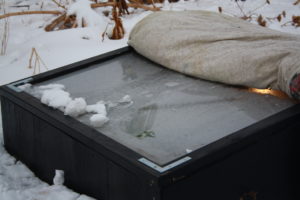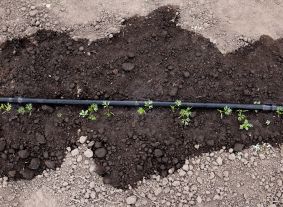Protecting Vegetables on Chilly Nights
Views: 5600

It’s the time of year when lengthening days and a sunny blue sky lure you out to the garden. Even though it’s still too soon without protecting your vegetables.
This Siren’s song tempts you to plant more in your veggie garden than you should. As I mentioned a few weeks ago, only the hardiest of veggies can tough it out through spring’s chilly temperatures.
Even when spring does become comfortably warm, Mother Nature can still throw a chilly night into the mix now and again. As April warms into May, your local weather forecaster will undoubtedly put up the red flag of a frost warning. All is not lost, however; with some supplies and quick action, you can protect your cold-sensitive veggies from Jack Frost.
Build a cold frame for protecting vegetables
If you really wish to get your garden in early, your cold-sensitive plants should be placed in a cold frame.
The frame part of a rectangular cold frame is typically made with bales of straw (which can be used as a garden mulch after its deconstruction), stacks of cinder blocks, or wood planks. Sow seeds or plant young transplants of summer veggie crops within the frame, and construct a lid of transparent materials—old glass window frames or a frame of clear plastic or plexiglass.
Prop open the lid on sunny days, as the air within will become quite warm, even too hot for the young plants inside. On cloudy early spring days, you’ll likely have to keep the lid closed or propped open just a tad. Cold early spring nights will also force you to close the lid. As spring progresses and the days warm, you can close the lid on the forecasted frosty nights.
Cover plants overnight
Cover your young veggie garden with heavy sheets, light blankets, thick plastic, or garden fabric. The covering will hold in any radiating heat from the soil, keeping the air underneath warmer than the chilly night air. If you fear you’ll crush some plants with the heavy covering, prop it up by inserting stakes near those plants. Be sure to remove the coverings the next morning.
Spray vegetables with water
The water on the leaves will absorb the cold before it gets to the plants themselves. And if any ice does form, that layer will protect the leaves from the chilly air above. This isn’t the best method of cold protection, and it won’t help your most sensitive veggies (like tomatoes and peppers) that suffer from damage even at above-freezing temperatures.
Use bottomless jugs and cartons for protecting vegetables
Place bottomless beverage jugs or cartons over your plants. This will hold in heat radiating from the soil, and also protects your plants from chilly winds during the day. Keep those jug tops or screw caps, too. You’ll be able to remove the tops for easy daytime ventilation.
You can also find a number of products and gadgets at your garden center and in garden supply catalogs and online stores, many of them aimed at protecting sensitive tomato plants (and allowing you to plant them that much earlier). One of the most interesting is a water teepee. It’s a plastic contraption with cells which you fill with water; the water absorbs solar energy during the day and radiates the heat at night, keeping the tomato or eggplant or pepper nice and cozy at night.
Best of luck with tempting Mother Nature!
Meet Ellen Wells
When you’re raised on a farm, you can’t help but know a thing or two about gardening. Ellen Wells is our expert on edible gardening.…
Ellen's Recent Posts

Asparagus






